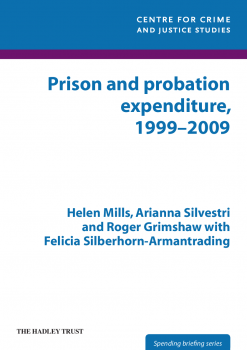Prison and probation expenditure, 1999-2009

Spending on the prison and probation system in England and Wales has grown by 36 per cent in real terms since 2004 despite a major reorganisation that was meant to save money, a report from the Centre for Crime and Justice Studies has found. Prison and probation expenditure 1999 - 2009 found that spending on the National Offender Management Service (NOMS) - which combines the costs of operating the prison, probation and headquarters function - rose in real terms from £3.6 billion in 2004/2005 to £4.9 billion in 2008/2009.
Despite this significant increase in expenditure, frontline resources have been increasingly overstretched. Public prisons have experienced successive annual real terms cuts in expenditure per prisoners since 2006 and overcrowding has increased. In probation, key frontline staffing groups peaked in 2006 and have since declined in the face of a continuing rise in the number of people subject to probation supervision.
The report also found that there were significant gaps in the information necessary to establish a comprehensive picture of prison and probation costs, making an informed public debate on penal expenditure very difficult. The lack of detailed cost breakdowns in publicly available reports means it is impossible to establish spending trends on key investments such as ITC, accredited programmes, or the cost of the three major reorganisations in this period.
Key facts from the report
On prisons:
- Between 2003/2004 and 2008/2009 prison expenditure in England and Wales increased by 38.9 percent in real terms, from £2.868 bn to £3.982 bn (Table 1, page 46). This followed a real terms decline of 3.2 percent between 1998/1999 and 2002/2003 (Table 2, p. 47). Figures for these two periods are not directly comparable due to different collation methods.
- Between 1998 and 2008 the average annual prison population grew by 26.5 percent (Table 7, p. 50).
- Staffing in the public prison system (disaggregated staffing figures which include private prisons are not readily publicly available) grew by 19.7 per cent between 1998/1999 and 2008/2009 (Table 11, p. 53).
- The average capital building cost per prison place increased by 66.3 percent in real terms between 1998/99 and 2008/09, from £85,397 to £142,000 (Table 10, p. 52).
On probation:
- Between 2000/01 and 2007/08 real terms expenditure on probation grew by 50 percent, from £665 m to £1 bn (Table 4, p. 48).
- Between 1998 and 2009 the average annual number of people subject to probation supervision grew by 38.7 per cent (Table 13, p. 55).
- Total probation staff grew by 46 percent between 1998 and 2008. Frontline staff grew by 64.8 per cent during this period, though they have declined by 17.4 percent since 2006. There were fewer frontline probation staff in 2008 than there were in 2003.
Dr Roger Grimshaw, director of research at the Centre for Crime and Justice Studies and one of the report co-authors said:
'Prison and probation expenditure has increased dramatically over the past decade. Yet the frontline is running to catch up with demand. How sustainable or desirable is this spending in the age of austerity and how realistic are the current demands placed on the criminal justice system?'
Richard Garside, director of the Centre for Crime and Justice Studies, said:
'This report documents in great detail Labour's audacious agenda to expand the size and reach of the prison and probation service. Its legacy is record expenditure, an overstretched workforce and an overburdened system. The current financial crisis offers a rare opportunity to rethink some basic assumptions about the size and scale of the prison and probation services and the demands we place on the staff working in them.'